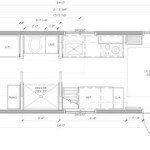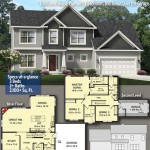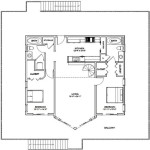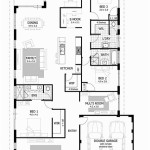Where Can I Find Floor Plans For A House?
Locating floor plans for a house can be vital for various purposes, ranging from planning renovations and remodeling to assessing property layouts and understanding the structural design. Whether you are a homeowner, a real estate investor, a contractor, or simply someone with a strong interest in architectural design, access to accurate and detailed floor plans can prove invaluable. Fortunately, numerous resources are available to assist in finding these architectural blueprints. The availability and accessibility of these resources depend on various factors, including the age of the house, the availability of public records, and whether the house was custom-built or part of a larger development. This article will explore several avenues for discovering floor plans, outlining the procedures and benefits associated with each.
Exploring Public Records and Building Departments
Public records, maintained by local government entities, are a primary resource for obtaining floor plans. City and county building departments often retain architectural plans submitted during the permitting process. These plans are usually available for public inspection, although restrictions may apply regarding reproduction and distribution. The process for accessing these records varies depending on the jurisdiction, but typically involves submitting a formal request to the relevant department. This request should include the property address and, if known, the date of construction or any prior renovations that required permits. Accessing older records may require more extensive archival searches, potentially incurring additional fees.
The advantages of obtaining floor plans from public records are numerous. These plans are typically official and accurate, providing a reliable representation of the property's layout at the time of its construction or latest permitted renovation. They often include detailed information about wall dimensions, room sizes, and the location of plumbing and electrical fixtures. Furthermore, accessing public records is generally a cost-effective option, although fees may apply for copies or archival research. However, it's important to acknowledge potential limitations. Not all properties have floor plans on file, especially older houses built before stringent permitting requirements were established. Additionally, the records may not reflect any unpermitted modifications or additions made to the property over time.
To effectively utilize public records, start by identifying the specific building department responsible for the property's location. Most municipalities have online portals providing information about permitting and record access. These portals often offer search functions to help locate relevant documents. If an online search proves unsuccessful, contacting the building department directly is recommended. Inquire about the procedures for requesting floor plans and any associated fees. Be prepared to provide detailed information about the property, as this will facilitate the record retrieval process. Depending on the jurisdiction, you may need to schedule an appointment to view the plans in person or submit a written request for copies.
Contacting the Original Architect or Builder
If the house was custom-built or developed as part of a smaller project, contacting the original architect or builder could be a viable option. Architects typically retain copies of their designs, and builders may also have records of construction plans. Establishing contact with the relevant professional can provide access to detailed floor plans and potentially offer insights into the property's design and construction. This approach is particularly useful for newer homes or residences where the architect or builder is still in practice.
The process involves researching the property's history to identify the architect or builder. Property records, historical societies, and local archives can offer clues about the individuals or firms involved in the construction. Once contact information is obtained, reach out to the architect or builder and inquire about the availability of floor plans. Be prepared to provide proof of ownership or authorization to access the plans, as architects and builders typically maintain confidentiality regarding their designs. If the original architect or builder is no longer available, their firm or descendants might possess the plans. Efforts to trace these connections could prove fruitful.
Securing floor plans from the original architect or builder offers several advantages. These plans are often the most accurate and detailed representations of the property's design, reflecting the original intent and specifications. They may also include additional information not found in public records, such as structural details, material specifications, and design notes. Furthermore, the architect or builder might offer insights into the property's construction challenges or unique features. However, there are limitations to this approach. The architect or builder may no longer retain the plans, or they may be unwilling to share them due to confidentiality concerns or copyright restrictions. Additionally, this approach is not feasible for properties built long ago, where the original architect or builder is difficult to trace.
Utilizing Online Resources and Real Estate Listings
The internet offers various resources for finding floor plans, ranging from online databases to real estate listings. Websites specializing in architectural designs often feature collections of floor plans for different house styles and sizes. These resources can offer inspiration and provide a general understanding of layout options. Real estate listings, particularly for newer properties, often include floor plans as part of the marketing materials. These plans can offer a glimpse into the property's layout and dimensions, although they may not be as detailed or accurate as official architectural blueprints.
Several websites cater to architectural design enthusiasts and professionals, offering a range of floor plans, house designs, and construction resources. These platforms typically allow users to search for floor plans based on various criteria, such as square footage, number of bedrooms, and architectural style. While these plans may not be specific to a particular property, they can provide valuable insights into typical layouts and design options. Real estate websites and online property portals often include floor plans for properties listed for sale or rent. These plans are usually included as part of the property's visual presentation, providing potential buyers or renters with a clear understanding of the layout. However, it is important to verify the accuracy of these plans, as they may be simplified or not drawn to scale.
Utilizing online resources can be a convenient and efficient way to explore floor plan options and gain a preliminary understanding of property layouts. These resources offer a vast selection of designs and can be accessed from anywhere with an internet connection. Real estate listings provide immediate access to floor plans for properties currently on the market, allowing potential buyers or renters to assess the layout and suitability. However, caution is advised when relying solely on online resources. Floor plans found on general architectural websites may not be specific to a particular property, and real estate listings may contain inaccuracies or outdated information. It is essential to verify the accuracy of any floor plan before using it for renovation or construction purposes. Always cross-reference the information with official records or consult with a qualified professional.
Hiring a Professional to Create Floor Plans
When other resources prove insufficient, engaging a professional to create floor plans may be the most reliable solution. Architects, draftsmen, and interior designers are skilled in creating accurate and detailed floor plans based on existing structures. This approach is particularly useful for properties where original plans are unavailable, for houses that have undergone significant renovations, or when detailed plans are required for remodeling or expansion projects.
The process involves hiring a qualified professional with experience in creating floor plans. Architects and draftsmen are trained in architectural design and drafting, possessing the skills necessary to create accurate and detailed plans. Interior designers can also create floor plans, focusing on interior spaces and layout options. When selecting a professional, consider their experience, qualifications, and portfolio. Obtain references and review their previous work to ensure they can meet your specific needs. The professional will typically visit the property to take measurements and assess the existing layout. They may use laser measuring tools or other specialized equipment to ensure accuracy. Based on their measurements and assessment, they will create a floor plan that accurately reflects the property's current layout. The floor plan can be provided in various formats, including digital files, printed copies, or 3D models.
Hiring a professional to create floor plans offers several advantages. The resulting plans will be accurate, detailed, and customized to the specific property. The professional can also incorporate any existing renovations or modifications into the plans, providing a complete and up-to-date representation of the property's layout. Furthermore, the professional can provide additional services, such as structural assessments, design consultations, and assistance with obtaining building permits. However, this approach is typically the most expensive option. Professional fees can vary depending on the size and complexity of the project, the experience of the professional, and the location. It is essential to obtain quotes from multiple professionals and compare their services and fees before making a decision.
In summary, finding floor plans for a house requires a strategic approach, considering the age of the property, availability of public records, and the specific purpose for which the plans are needed. Exploring public records and contacting the original architect or builder are cost-effective options for obtaining official plans. Utilizing online resources and real estate listings can provide a preliminary understanding of layout options. When other resources are insufficient, hiring a professional to create floor plans ensures accuracy and customization. By carefully considering these options, individuals can obtain the floor plans necessary for various purposes, from planning renovations to understanding the structural design of a property.

House Plans How To Design Your Home Plan

Floor Plans Types Symbols Examples

House Plans How To Design Your Home Plan

Floor Plans Types Symbols Examples

House Plans How To Design Your Home Plan

Top Tips For Choosing A Floor Plan Your New Home

House Plans How To Design Your Home Plan

Where You Can Buy House Plans Live Home 3d

Peach Tree House Plan Ranch Floor Designs

Importance Of House Floor Plans In Architectural Design
Related Posts








